Many broadleaf weed species are found in sugarcane fields on organic soils in the Everglades Agricultural Area and surrounding mineral soils in south Florida. Weeds compete with sugarcane for light, water, and nutrients, resulting in significant sugarcane yield loss when adequate control measures are not taken. The mature weeds also produce seeds and increase weed control problems by being a source of seedbank replenishment and reinfestation in subsequent years.
Proper broadleaf weed identification is an important first step in developing a successful weed management program in sugarcane. Identification of broadleaf weeds at the seedling stage and early in the vegetative stage of growth when they are most vulnerable to control measures is important in developing effective management plans.
Broadleaf weed seedlings have two seed leaves or cotyledons. True leaves are wide or broad with a main vein (midvein) in the center; smaller veins form and branch, resulting in netlike venation. Stems can be rounded or angled in cross-section. Roots are fibrous or can have a primary taproot with smaller lateral roots, or both. Broadleaf weeds are classified as annuals, biennials, or perennials based on their life cycle. Annuals live and produce seeds within one year. Biennials live more than one year but not more than two years. Perennials produce vegetative structures that allow them to regrow for three or more years, although some also produce seeds.
This publication describes the proper identification of broadleaf weed seedlings commonly found in Florida sugarcane fields and aims to assist growers in selecting effective control measures. Identification of broadleaf weeds at the seedling stage is important because control measures should be implemented when weeds are at the early vegetative growth stage.
Vegetative Parts for Identifying Broadleaf Seedlings
Broadleaf weed seedlings can easily be identified by specific characteristics of the cotyledons, leaves, and stems (Figure 1). Cotyledons vary in shape and size, and generally reach their full size by the time the first true leaves develop and become visible (Figure 2). Cotyledons can be smooth, hairy, or rough. The size and shape of first true leaves and later leaves will vary considerably among species (Figure 3). Leaves may be alternate, opposite, or whorled, or form a basal rosette around the stem (Figure 1). Margins of leaves can be entire, wavy, rounded, toothed (serrated), or lobed (Figure 4). The shape of leaves will vary considerably among species. Leaves may be attached to the stem by a petiole (leafstalk), or they may be sessile (attached directly to the stem).
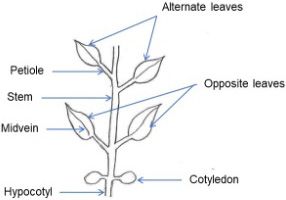
Credit: D. C. Odero, UF/IFAS

Credit: D. C. Odero, UF/IFAS

Credit: D. C. Odero, UF/IFAS

Credit: D. C. Odero, UF/IFAS
The identifying characteristics of 14 broadleaf weed seedlings commonly found in Florida sugarcane fields are listed below to help with their identification.
Common Lambsquarters (Chenopodium album)
Family: Chenopodiaceae (goosefoot family).
Life Cycle: Annual.
Cotyledons: Linear, green, and hairless.
Leaves: First true leaves and subsequent leaves are lanceolate to ovate. The first pair of leaves is opposite with smooth margins. Later leaves are alternate and have unevenly toothed margins, a gray-mealy coating on the underside and above the surface, and long petioles.
Stem: Green or tinged with red, hairless, covered with mealy white granules, and erect.

Credit: D. C. Odero, UF/IFAS
Spiny Amaranth (Amaranthus spinosus)
Family: Amaranthaceae (pigweed family).
Life Cycle: Annual.
Cotyledons: Linear, dull green on the upper surface, bright red beneath, and hairless.
Leaves: First true leaves are ovate, hairless, dull green, and slightly notched at the tip. Subsequent leaves are egg-shaped, hairless, slightly notched at the tip, and alternate, and they have long purple petioles. The leaves sometimes have a reddish hue along the midvein. Leaf margins are wavy.
Stem: Red, hairless, erect, with a pair of very sharp, stiff spines at the nodes.

Credit: D. C. Odero, UF/IFAS
Smooth Pigweed (Amaranthus hybridus)
Family: Amaranthaceae (pigweed family).
Life Cycle: Annual.
Cotyledons: Linear and reddish green.
Leaves: First true leaves are ovate, green, hairless, and slightly notched at the tip. Subsequent leaves are oval to egg-shaped, hairless, alternate, green above and light green below, and slightly notched, with long petioles. Leaf margins are less wavy.
Stem: Red to green but reddish toward the base; usually slightly hairy on upper parts, and erect. The nodes do not have any spines.
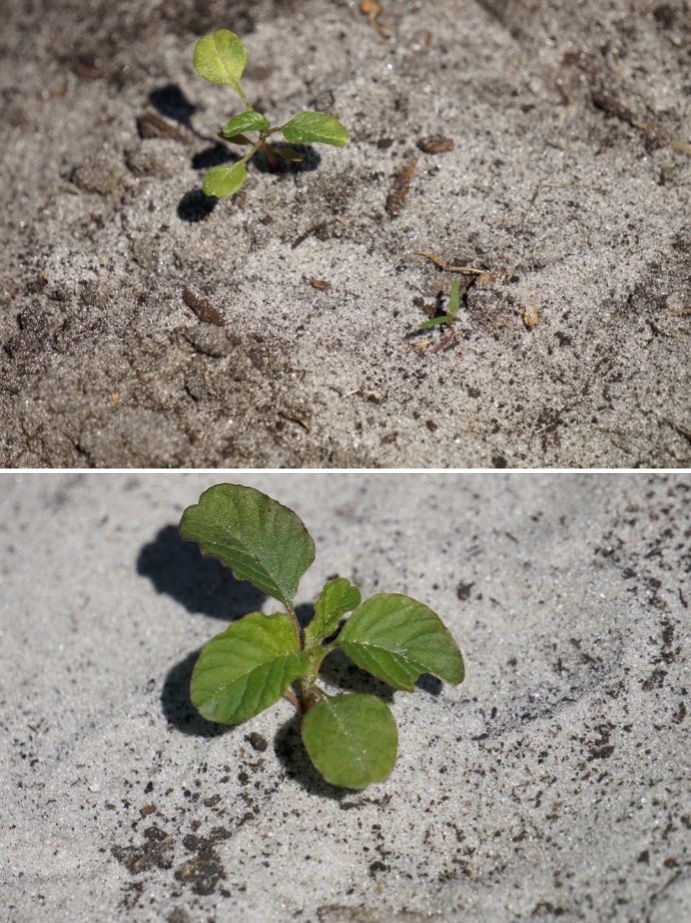
Credit: D. C. Odero, UF/IFAS
Livid Amaranth (Amaranthus blitum)
Family: Amaranthaceae (pigweed family).
Life Cycle: Annual.
Cotyledons: Linear, purplish, and hairless.
Leaves: First true leaves are ovate, purplish-green, hairless, and notched at the tip. Subsequent leaves are ovate, hairless, alternate, notched at the tip, and reddish-green or green, with long purple petioles. Leaf margins are entire.
Stem: Red, hairless, prostrate to ascending or radiating from the base; can be branched.
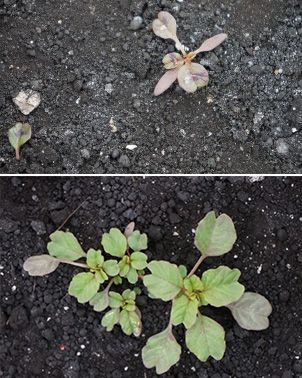
Credit: D. C. Odero, UF/IFAS
Common Purslane (Portulaca oleracea)
Family: Portulacaceae (purslane family).
Life Cycle: Annual.
Cotyledons: Linear, succulent, hairless, green or purplish-red on the top surface, and purplish-red underneath.
Leaves: First true leaves are lanceolate and become obovate, green, hairless, succulent, and opposite, with rounded tips. Subsequent leaves are spatulate or obovate, broad, rounded at the tip, narrow towards the base, succulent, red-tinged, hairless, and sessile. The leaves are opposite and oriented 90° from the previous pair. Leaf margins are entire.
Stem: Reddish, succulent, erect at an early stage; becomes prostrate after branching or at later growth stage.
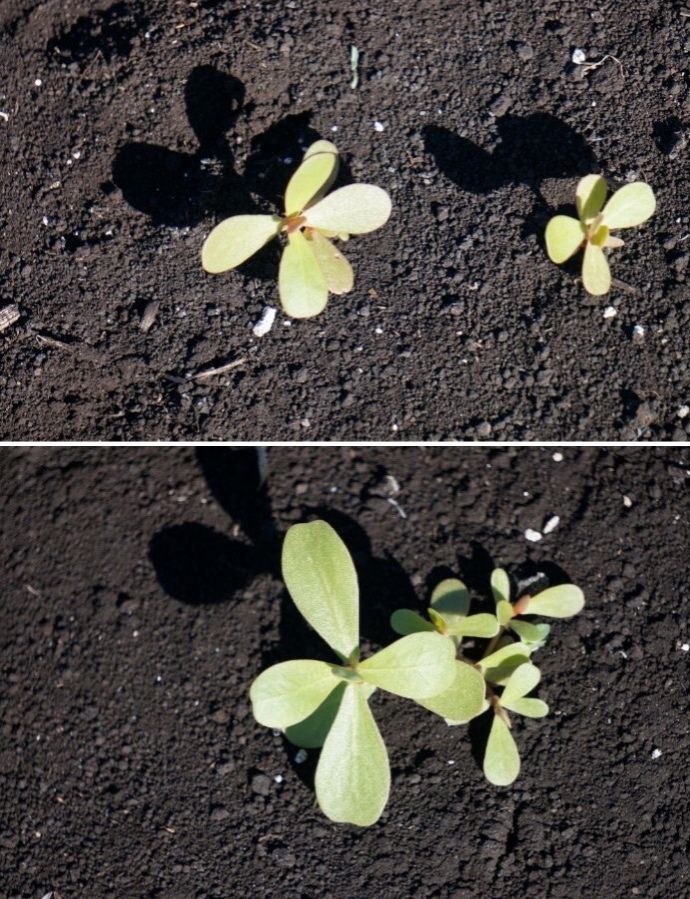
Credit: D. C. Odero, UF/IFAS
American Black Nightshade (Solanum americanum)
Family: Solanaceae (nightshade family).
Life Cycle: Annual.
Cotyledons: Ovate to lanceolate, small, and green.
Leaves: First true leaves are ovate. Subsequent leaves are alternate, ovate, dark green, and covered with small hairs. The midvein is evident on the lower surface and the petiole is covered with small hairs. Leaf margins are entire to somewhat wavy.
Stem: Purplish, erect, and hairy.
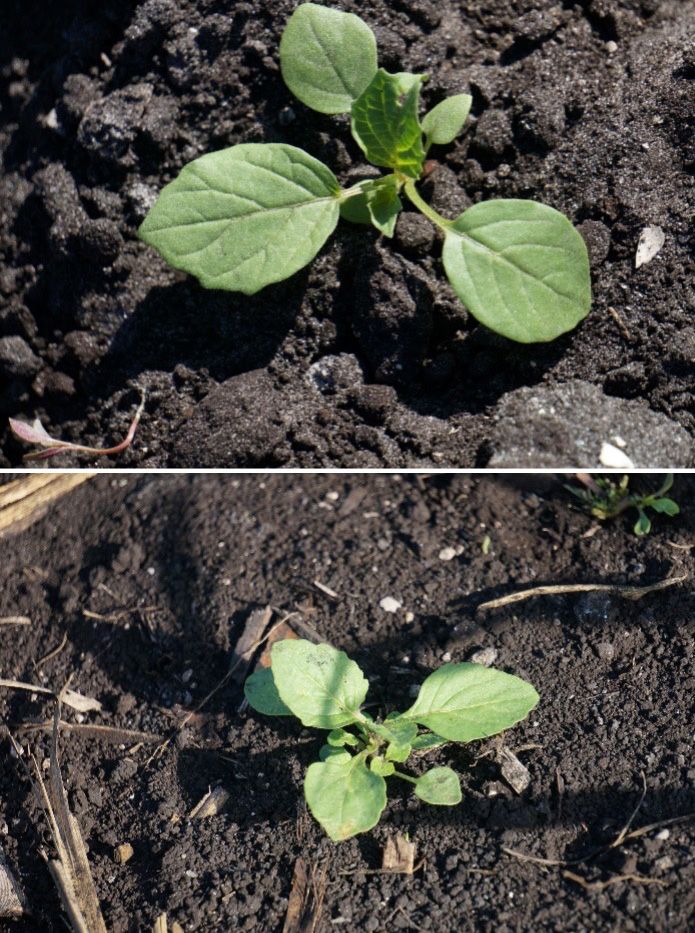
Credit: D. C. Odero, UF/IFAS
Ragweed Parthenium (Parthenium hysterophorus)
Family: Asteraceae (sunflower family).
Life Cycle: Annual.
Cotyledons: Rounded paddle shape on short stalks.
Leaves: First true leaves are egg-shaped, opposite, and covered in fine, white hairs. Subsequent leaves form on short petioles and become increasingly lobed and deeply divided. Older leaves form a basal rosette and are light green and hairy with white veins on both sides.
Stem: Basal rosette; later becomes erect, green, and hairy.
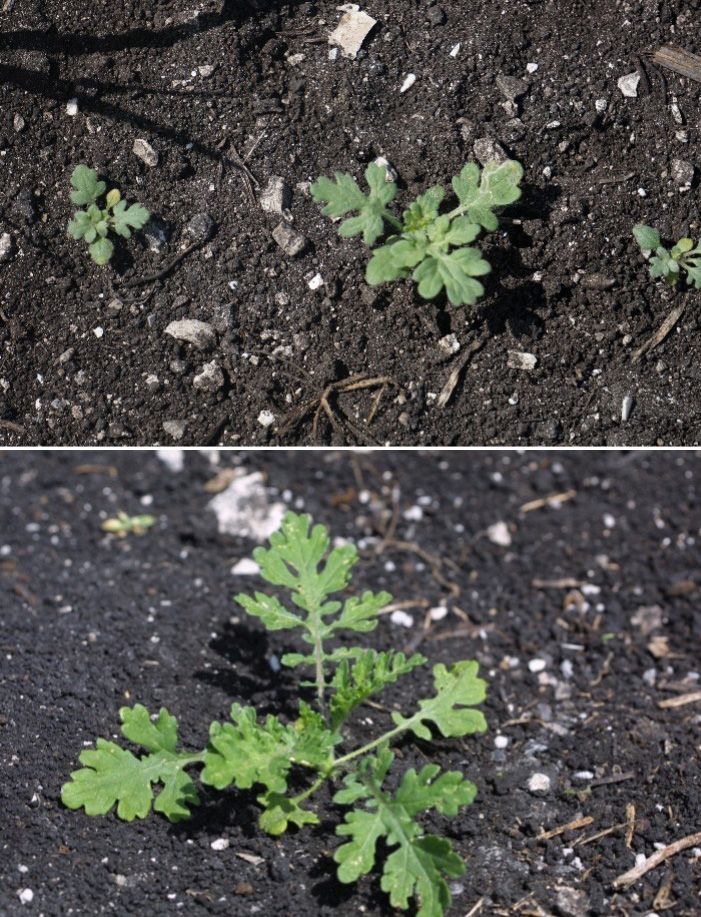
Credit: D. C. Odero, UF/IFAS
Common Ragweed (Ambrosia artemisiifolia)
Family: Asteraceae (sunflower family).
Life Cycle: Annual.
Cotyledons: Spatulate, hairy, with purple spots around the margin. The upper surface is green with a purple underside.
Leaves: First true leaves are lobed and hairy. Later leaves are deeply cleft, twice compound, and hairy. The youngest leaves look opposite and become alternate by the fourth node. Leaves are borne on long, hairy petioles.
Stem: Purple, erect, and hairy.
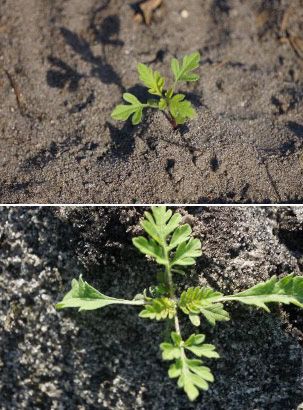
Credit: D. C. Odero, UF/IFAS
Coffee Senna (Senna occidentalis)
Family: Fabaceae (bean family).
Life Cycle: Annual.
Cotyledons: Rounded, smooth above, with white hairs below (distinguishing it from sicklepod).
Leaves: First true leaf is pinnately compound with 4 oval leaflets that have pointed tips. Subsequent leaves are alternate, pinnately compound, with 4 to 6 pointed leaflets that have pointed tips. Leaf veins are prominent. The terminal pair of leaflets is larger than the basal pair. Leaf margins are entire and have short hairs.
Stem: Green, erect, and smooth.
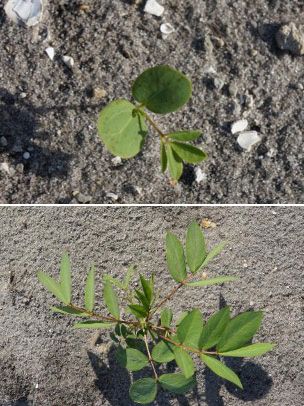
Credit: D. C. Odero, UF/IFAS
Sicklepod (Senna obtusifolia)
Family: Fabaceae (bean family).
Life Cycle: Annual.
Cotyledons: Rounded with 3 to 5 distinct veins, smooth above; no white hairs below (distinguishing it from coffee senna).
Leaves: First true leaf is pinnately compound with 4 obovate leaflets. Subsequent leaves are alternate, pinnately compound, with 4 to 6 oval leaflets that have rounded tips. The terminal pair of leaflets is larger than the basal pair. Leaf margins are entire and have short hairs. Leaves omit a foul smell when crushed.
Stem: Green, erect, and smooth.
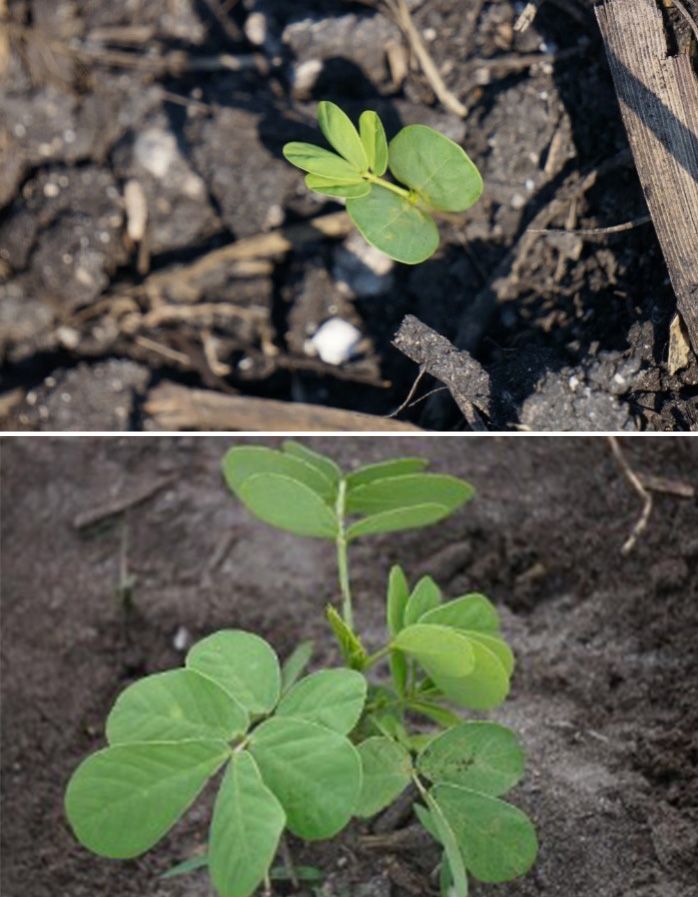
Credit: D. C. Odero, UF/IFAS
Pitted Morningglory (Ipomea lacunosa)
Family: Convolvulaceae (morningglory family).
Life Cycle: Annual.
Cotyledons: Butterfly shaped and more deeply notched at the tip, with a greater angle of the notch and slenderer and pointed lobes.
Leaves: First true leaves and subsequent leaves are heart shaped, hairless, and alternate, and taper to a more pointed tip. Leaf margins are entire and purple in color.
Stem: Maroon at the base, green at the top, vine-like, and smooth.
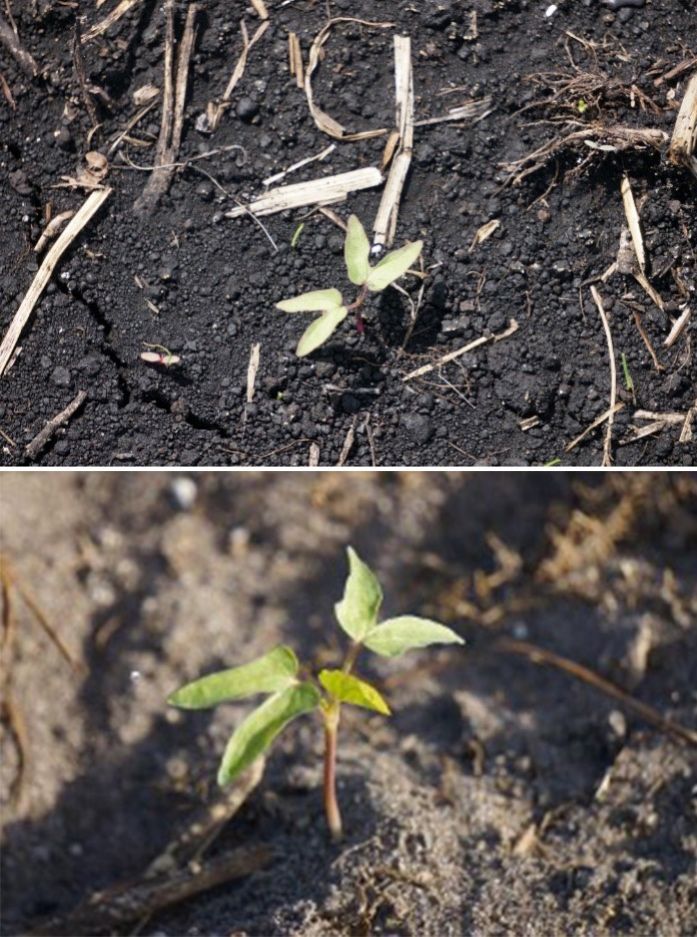
Credit: D. C. Odero, UF/IFAS
Smellmelon (Cucumis melo)
Family: Cucurbitaceae (cucumber family).
Life Cycle: Annual.
Cotyledons: Broadly ovate with a slight notch at the tip, green, and hairless.
Leaves: First true leaves and subsequent leaves are rough, rounded, angled but not lobed, alternate, and hairy. Leaf margins are wavy with sharp teeth that point outward. The leaves are borne on long petioles covered with soft hairs.
Stem: Green and covered with soft hairs, vine-like.

Credit: D. C. Odero, UF/IFAS
Pennsylvania Smartweed (Polygonum pensylvanicum)
Family: Polygonaceae (buckwheat family).
Life Cycle: Annual.
Cotyledons: Lanceolate, rounded tips, smooth, with reddish blotch underneath; gland-tipped hairs on the margins.
Leaves: First true leaves are lanceolate to elliptic. Subsequent leaves are alternate, lanceolate, pointed at the tip, hairy on the upper surface and margins, smooth underneath, sometimes with purple blotches in the center of upper and lower surfaces. Leaves are borne on short petioles surrounded by conspicuous smooth membranous sheaths (ocrea) at the base.
Stem: Smooth, reddish-purple, with swollen and angled nodes surrounded by ocrea (a papery sheath formed by fusion of stipules at the base of a leaf).
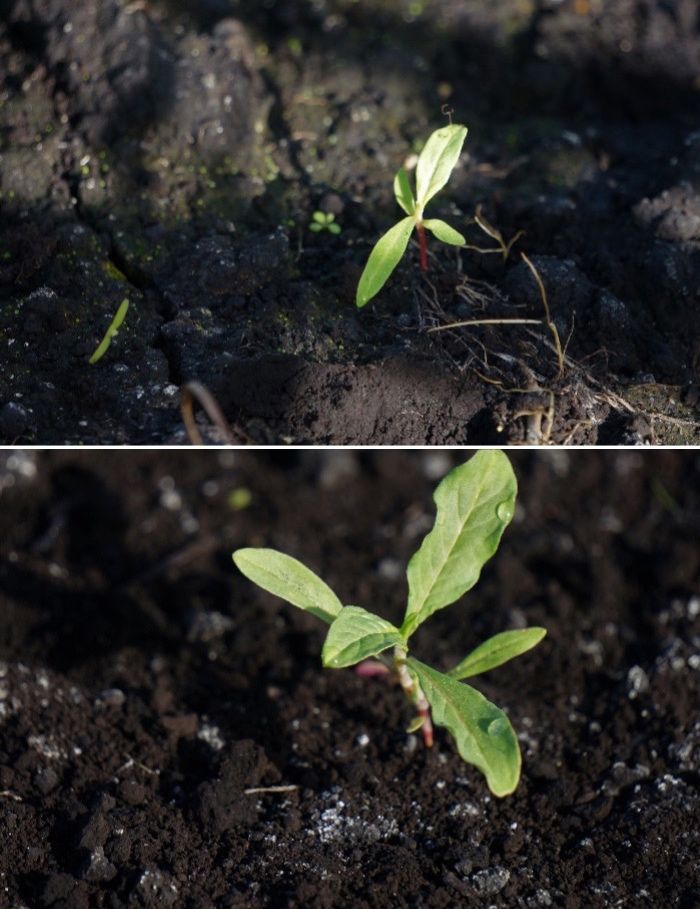
Credit: D. C. Odero, UF/IFAS
Carpetweed (Mollugo verticillata)
Family: Molluginaceae (carpetweed family).
Life Cycle: Annual.
Cotyledons: Oblong, thick, and smooth.
Leaves: First true leaves and subsequent leaves form in whorls; they are thickened, rounded above and narrow at the base, dull green, smooth, and pale underneath. The leaves are borne on very short petioles with few marginal hairs. Leaf margins are entire.
Stem: Develops a small basal rosette.
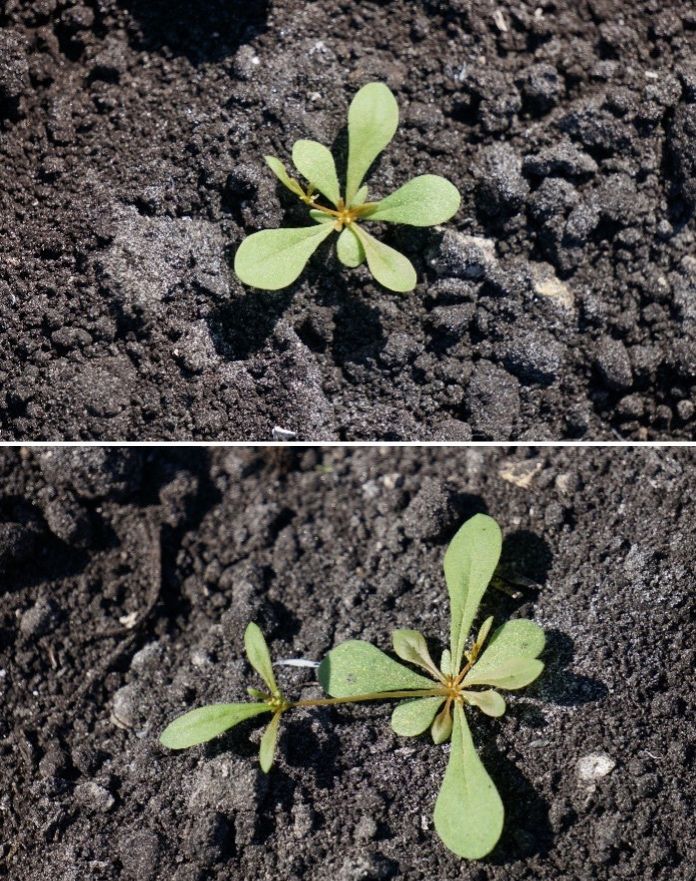
Credit: D. C. Odero, UF/IFAS